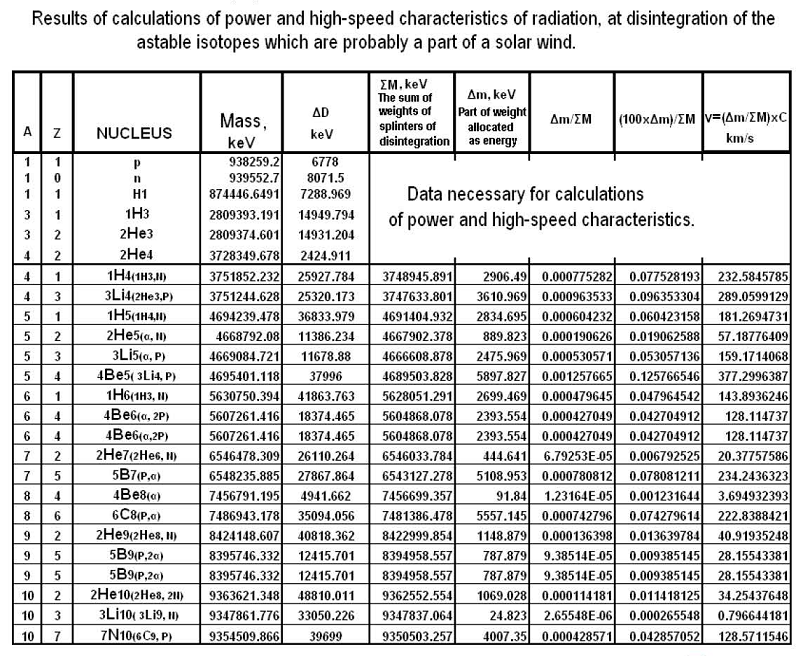Having compared schedules №G-4.1 and №G-4.2, we see, that in the first case, at the moment of the achievement of kernel «c» charges zc=27 – 32, the high-speed characteristic sharply decreases. In the second case, the decrease in the high-speed characteristic is smoother, but the disorder of speeds in the second case is wider, than in the first. In the first case, the high-speed characteristics are denser. It is visible well on schedules №G-4.1a and №G-4.2a where the final area of the high-speed characteristics of kernel «c» is shown at zc=25 – 36.
On the density of disorder of kernels speeds in «the solar wind», it is possible to assume which processes of synthesis occur on the star surface, with the participation of heavier kernels, or only under the action of easy kernels. Despite the difference in schedules, we can draw one main conclusion, for these and other cases: «in the process of synthesis of kernels «a» and «b», the speed of the received kernel «c», decreases, with the increase in its weight and charge».
The reason of speed decrease in the synthesized kernel «c», is the decrease of allocated energy, in the process of synthesis and the increase in the weight of kernel «c». That means, at the reduction of allocated energy and increase in the kernel’s weight, the speed of kernel «c» decreases and reaches values, in which the kernel is not capable to overcome the force of gravitation and the magnetic forces of a star. And that does not allow many kernels with zc >27 – 32 to be a part of «the solar wind».
— Secondary radiation
Analyzing the chemical compound, high-speed characteristics of «the solar wind» and the results of our calculations, questions arise: «Where from come the protons, neutrons and kernels of helium with different high-speed characteristics in the structure of «the solar wind»?». In fact, in the analysis of easy kernels synthesis lead by us, the given particles are absent, and in the case of their presence, there is no much big high-speed and power disorder.
The answer to this question is very simple. Having looked on the table №A-2, we see a huge quantity of unstable isotopes, whose time of half-decay is less than seconds, less than minutes, less than an hour, less than a day and so on. As a result of the disintegration of these isotopes protons, neutrons, and kernels of helium are being allocated.
The kernel of an unstable isotope can be compared to a rocket with some steps. At the moment of synthesis of two kernels or more, the received kernel «c» receives a jet impulse, due to the allocation of part of the weight as radiation. Moving with the speed vc, the kernel breaks up and radiates energy and particle. In this case, the speed of kernel changes — increases or slowing down, depends on the direction of energy radiation and the given particle, as shown in fig. №R-4.14.

(78) Figure №R-4.14
Where vc— Speed of kernel «C», after the synthesis of kernels;
vc1— Speed of kernel «C», after the disintegration and radiation of a proton;
vpc -Speed of a proton concerning a kernel «C»;
vp — speed of a proton.
On fig. №R-4.14, two variants of radiation of a particle are shown. In the first case, radiation of proton occurs in the opposite party of «C» kernel movement, in this case the speed of kernel «C» increase. The speed and direction of movement of the proton depend on the weight of kernel «C» and on the impulse received.
Two variants are possible, the proton continues to move to the same party, as kernel «C», but its speed is lower than the speed of kernel «C». Or, the proton moves to the opposite party movement of kernel «C», thus, its speed will depend on s the speed of kernel «C» and on the impulse received by it. According to the third law of Newton, in the second case when the proton is radiated in the direction of movement of kernel «C», the speed of a kernel decreases, and the speed of the proton increases concerning the initial speed of kernel «C».
Hence, the structure of «the solar wind» is not only combined and variableon chemical compound, but combined and variableon the power and high-speed ranges.
Let’s analyze the power and the high-speed characteristics of kernels and particles of secondary radiation.
The secondary radiation appears as a result of disintegration of unstable isotopes, received in the process of synthesis in the active zone of a star. From table №A-2 we have chosen the unstable isotopes and have brought them into table №T-4.4. The table №T-4.4, is a calculation of the power and high-speed characteristics in the tabulated form, at the disintegration of the unstable isotopes.
In the first column, the quantity of nuclides in the isotope kernel, in the second — specified the charge of an isotope, in the third column specified the designation of an isotope, in the brackets there are the results of disintegration of the given isotope. In the fourth column the weights of unstable isotopes are given. In the fifth column, parameters ΔD=M-A are given.
In the sixth — the sum of disintegration splinters weights after the of isotopes ΣM. In the seventh — Δm, part of the weight allocated as energy Δm =M — ΣM.
In the eighth — the results of calculation, the attitude of weight allocated as energy to the sum of disintegration splinters weights of (Δm/ΣM), this parameter is necessary for calculation of the high-speed characteristic. In the tenth column, the results of calculations of the high-speed characteristic are yielded — which speeds should the disintegration splinters receive, provided that they are allocated in one direction. In case if the splinters will be allocated in different directions, part of splinters will receive greater speed, and other part of splinters should move with smaller speed, but averagely, there will be conformity to data in table № T-4.4.


